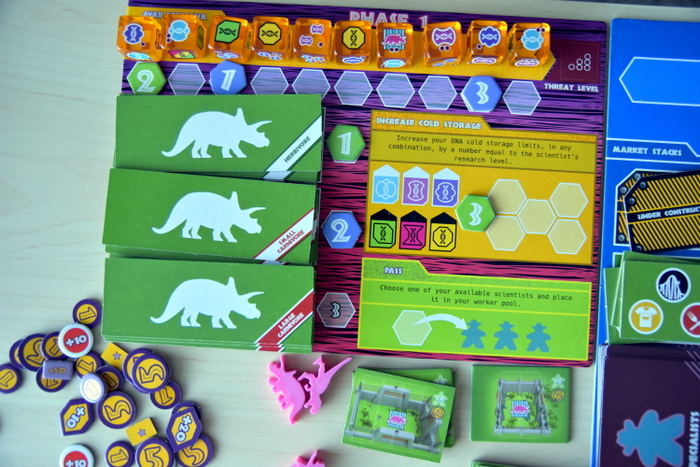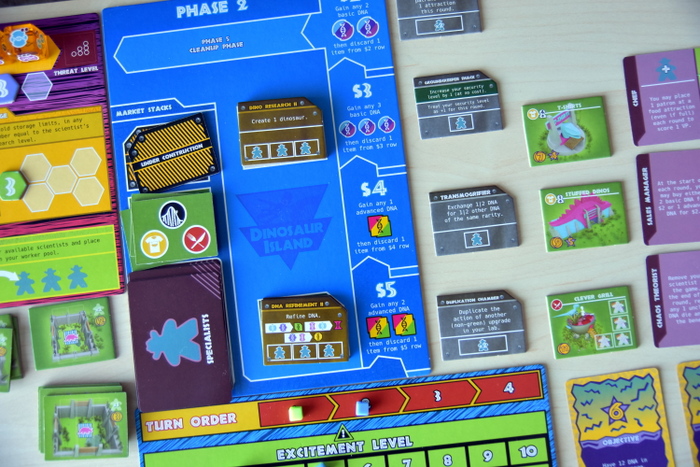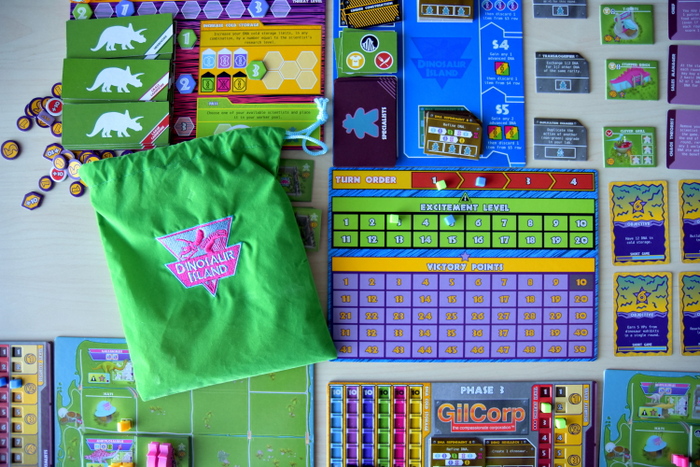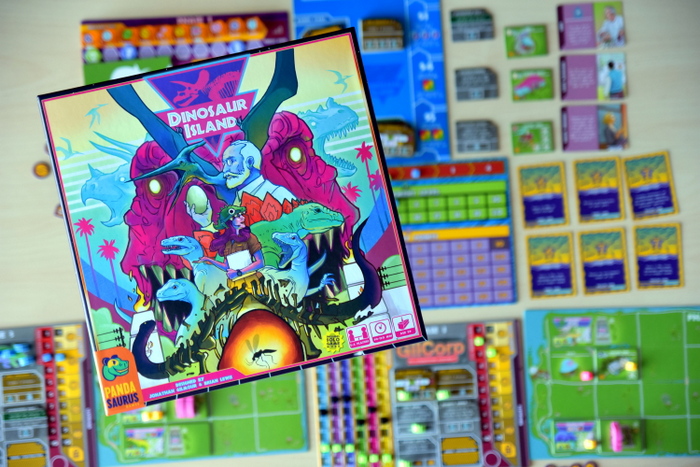This is clearly a game for our dinosaur loving friends! If you’re not a huge dinosaur fan, that’s ok, you’ll still love this game!
Dinosaur Island is an amusement park themed (think Jurassic Park) strategy game for players 8+. Learning a new game always feels a little daunting and sometimes games can feel more complicated than they really are at first, so learn this one on your own for sure but then invite all the kids to play the second time.
One to four people can play and the game takes 1-2 hours. We love long games – they start slow but by the end things really pick up momentum and longer games always have so much excitement and suspense by the end, it’s amazing!
The game is played through 5 phases, and they each go pretty quickly.
At the beginning of the game, each player is assigned a Phase 3 player board with a fictional corporation name. You’re the head of a company that is trying to build the best theme park and you have a team of scientists and workers at your disposal to help.

In Phase 1 (Research Phase), each player has 3 scientists to employ to get DNA, increase cold storage, or buy dinosaur recipes.

One of the possible actions is to use a scientist to get more DNA, as shown on this set of amber colored dice. Each die pictures a kind and number of DNA. The dice are re-rolled each round and are the main way players get the genetic material needed to create their dinosaurs.
But first you have to buy a dinosaur with space for park visitors to hang out. It’s the classic board game set up – you need everything but your resources are limited and choices must be made!

Phase 2 is the Market Phase where players can hire specialists (special action cards), build attractions (extra spots for visitors to go), upgrade labs (increase actions in Phase 3), or purchase DNA (to use for building a dinosaur in Phase 3).
Each player gets 2 turns to buy from the market each round.

Phase 3 is the Worker Phase – players use the 4 workers they start the game with (those little green guys in the center) to
- refine DNA (trading two basic DNA for one advanced DNA),
- create dinosaurs (paid for with DNA according to the recipe on the dinosaur card from Phase 1),
- upgrade paddock capacity (to allow more dinosaurs at one location and get more visitors)
- increase security level (to keep everyone safe…it is a dinosaur park after all!)
- raise money (collect from the bank to use during Phase 2: Market Phase of the next round)
Phase 4 is the Park Phase. There is one visitor allowed per dinosaur, which is why upgrading paddock capacity and building more than one dinosaur in a single location is a good idea. More dinosaurs means more visitors! Attractions (purchased in the Market Phase) also entertain one visitor.
Throughout the game, a player’s Excitement Level is increasing as he acquires new attractions and dinosaurs. During the 4th phase, players get to pick a number of visitors out of the bag equal to their excitement level.
In the bag are pink visitors who pay and yellow visitors (hooligans) who sneak in and don’t pay. Hooligans must be placed in your park first, and it’s the luck of the draw!
Each visitor in your park earns you $1. Players collect their money and then move to the clean up phase – moving workers and scientists back to the starting location and refreshing all the market options from Phase 2.
The game ends when the game objectives are met. These objective cards are drawn at the beginning of the game and come in short, medium, or long game varieties. I love this element of the game – a lineup of short game objectives gives you a shorter game! We usually play with some of each. This is the way the game is different every time, the objectives to meet to end the game are always different, giving the game ultimate replayability!
And that’s it in a nutshell!
Five awesome phases, hooligans, strategy, dinosaurs, theme parks…the best!
The GAMESCHOOLING possibilities are endless with Dinosaur Island – there’s the obvious prehistoric science connection but also biology, genetics, business management, economics, and math!
Strategy games like this do wonders for kids. They help them with social skills, negotiating abilities, brainstorming, problem solving, abstract thinking, logic. If you’re not sold on the benefits of gameschooling yet, grab this game and try it out, you’ll be amazed at the thinking and brain work that goes on in your family.
Thanks to Pandasaurus Games for sharing this favorite with us!








